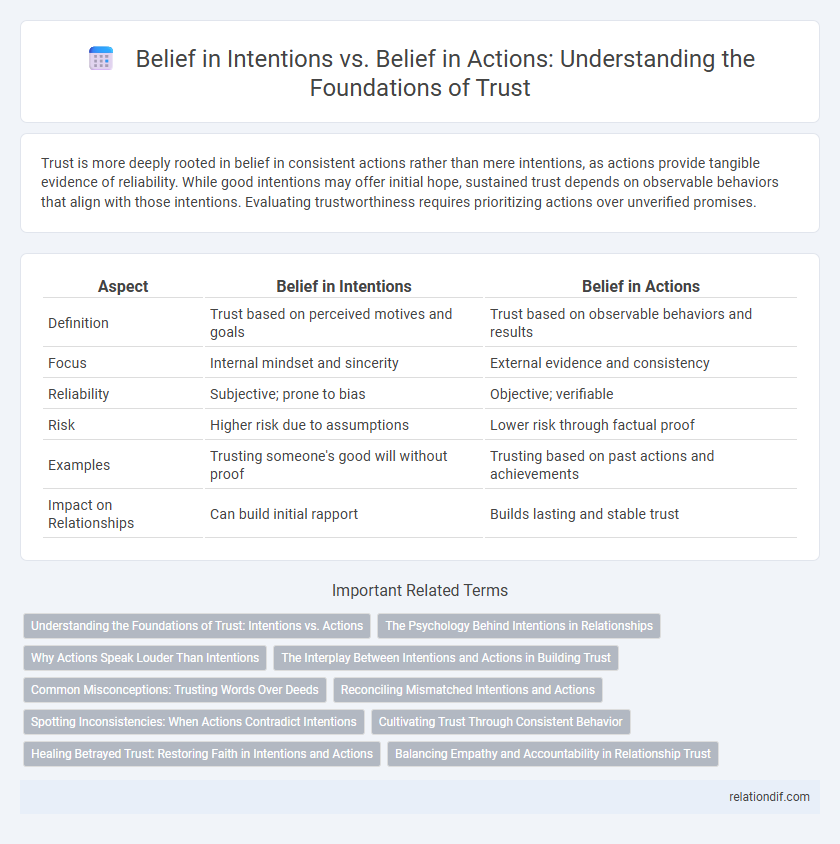Trust is more deeply rooted in belief in consistent actions rather than mere intentions, as actions provide tangible evidence of reliability. While good intentions may offer initial hope, sustained trust depends on observable behaviors that align with those intentions. Evaluating trustworthiness requires prioritizing actions over unverified promises.
Table of Comparison
| Aspect | Belief in Intentions | Belief in Actions |
|---|---|---|
| Definition | Trust based on perceived motives and goals | Trust based on observable behaviors and results |
| Focus | Internal mindset and sincerity | External evidence and consistency |
| Reliability | Subjective; prone to bias | Objective; verifiable |
| Risk | Higher risk due to assumptions | Lower risk through factual proof |
| Examples | Trusting someone's good will without proof | Trusting based on past actions and achievements |
| Impact on Relationships | Can build initial rapport | Builds lasting and stable trust |
Understanding the Foundations of Trust: Intentions vs. Actions
Trust is fundamentally built on the alignment between belief in intentions and belief in actions, where intentions represent the underlying motives, and actions provide tangible evidence of those motives. While intentions reveal commitment and integrity, consistent actions validate reliability and reinforce trustworthiness. Understanding this dynamic helps distinguish genuine trust from mere perception, emphasizing that trustworthy behavior is confirmed through a pattern of intentional actions.
The Psychology Behind Intentions in Relationships
Belief in intentions within relationships plays a crucial role in establishing trust by shaping how partners interpret each other's motives, even when actions may seem ambiguous or contradictory. Psychological research highlights that people often rely on inferred intentions to maintain emotional security and predict future behavior, fostering resilience during conflicts. Understanding the distinction between intentions and actions helps individuals navigate trust dynamics more effectively, promoting healthier and more empathetic connections.
Why Actions Speak Louder Than Intentions
Actions reveal true intentions by providing observable evidence of commitment, making them more reliable than mere stated beliefs. Psychological studies indicate people weigh consistent behaviors over verbal promises when assessing trustworthiness, as actions minimize ambiguity and demonstrate accountability. Trust solidifies through repeated positive actions, which confirm genuine intentions and foster stronger interpersonal connections.
The Interplay Between Intentions and Actions in Building Trust
Trust is fundamentally shaped by the alignment between intentions and actions, where consistent behavior confirms the sincerity behind expressed motives. While intentions reveal an individual's or organization's underlying purpose, trust solidifies only when those intentions translate into observable, reliable actions over time. This dynamic interplay ensures that trust is not merely an abstract belief but a practical outcome of demonstrated commitment and accountability.
Common Misconceptions: Trusting Words Over Deeds
Trust is frequently misplaced when individuals prioritize spoken intentions over observable actions, leading to misconceptions about reliability. Research indicates that consistent behavior is a stronger predictor of trustworthiness than promised intentions, as actions provide tangible evidence of character. Misjudging the weight of words can result in vulnerability and erosion of genuine trust in personal and professional relationships.
Reconciling Mismatched Intentions and Actions
Belief in intentions often conflicts with observable actions, creating a trust gap that requires careful reconciliation. Evaluating consistent behavioral patterns alongside expressed intentions helps align perceptions and fosters genuine trust. Transparent communication bridges discrepancies by clarifying motives behind actions, ensuring trust is built on both intent and evidence.
Spotting Inconsistencies: When Actions Contradict Intentions
Spotting inconsistencies between expressed intentions and actual actions reveals the true nature of trustworthiness. Trust strengthens when actions consistently align with stated intentions, while discrepancies raise doubts and signal potential deception. Evaluating behavior patterns over time provides critical insight into the reliability and integrity of individuals or organizations.
Cultivating Trust Through Consistent Behavior
Cultivating trust hinges more on consistent actions than mere declarations of intent, as repeated behaviors provide tangible evidence of reliability and integrity. Individuals interpret consistent actions as a stronger indicator of genuine commitment, reducing uncertainty in relationships and fostering deeper confidence. Trust solidifies when patterns of behavior align with promised intentions, creating a predictable and secure foundation for collaboration.
Healing Betrayed Trust: Restoring Faith in Intentions and Actions
Healing betrayed trust requires aligning consistent actions with genuine intentions to rebuild credibility and emotional safety. Transparent communication and accountability reinforce the belief that future behaviors will honor commitments, promoting restoration of confidence. Restoring faith hinges on demonstrating sincere efforts through tangible changes rather than mere proclamations of intent.
Balancing Empathy and Accountability in Relationship Trust
Balancing empathy and accountability in relationship trust requires recognizing the difference between belief in intentions and belief in actions. Trust strengthens when partners validate each other's intentions with empathy while holding each other accountable through consistent and reliable behaviors. This equilibrium fosters a resilient connection where sincerity and responsibility coexist, enhancing mutual respect and understanding.
Belief in intentions vs belief in actions Infographic

 relationdif.com
relationdif.com